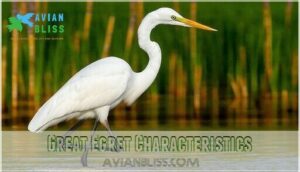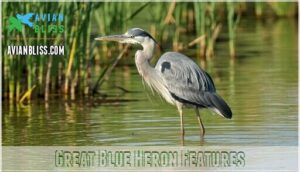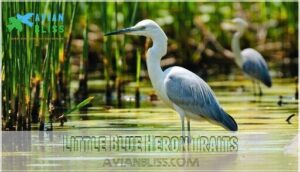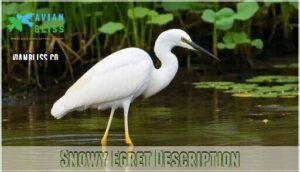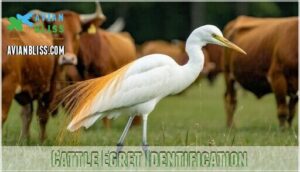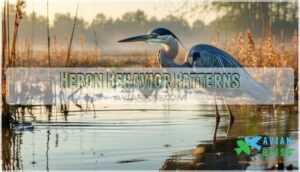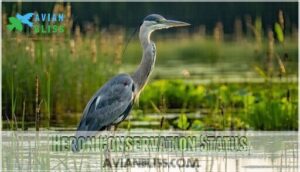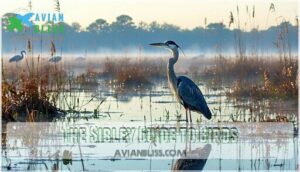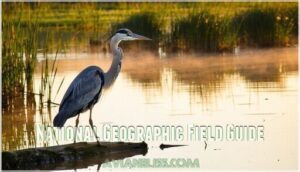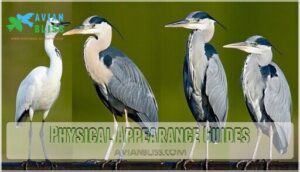This site is supported by our readers. We may earn a commission, at no cost to you, if you purchase through links.
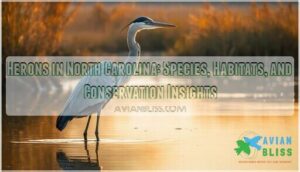
Species like the Great Blue Heron, Great Egret, and Little Blue Heron thrive in the state’s diverse habitats, from salty coastal swamps to quiet freshwater creeks.
These graceful birds are expert hunters, using razor-sharp reflexes to snag fish and frogs.
They’re also colonial nesters, forming bustling rookeries that hum with life each spring.
Habitat loss and pollution, though, can threaten their populations, and it’s interesting to learn how North Carolina protects these elegant birds—their conservation stories might surprise you.
Table Of Contents
Key Takeaways
- You’ll find diverse heron species in North Carolina, like the Great Blue Heron and Snowy Egret, thriving in habitats like wetlands, ponds, and urban areas.
- Herons are expert hunters with unique behavior, like motionless wading and quick strikes to catch fish and other prey.
- Conservation efforts focus on tackling habitat loss, pollution, and human disturbance to ensure herons survive and maintain ecosystem balance.
- You can identify herons by observing features like plumage color, leg length, and beak shape, using guides like The Sibley Guide to Birds for accuracy.
Heron Species Overview
You’ll find North Carolina is home to an impressive variety of heron species, each with unique features and behaviors.
From the striking Great Egret to the adaptable Cattle Egret, these birds thrive in diverse habitats across the state.
Great Egret Characteristics
The Great Egret, with its striking white plumage, yellow beak, and black legs, is a standout in wetland habitats.
The Great Egret dazzles with its elegant white plumage, vibrant yellow beak, and sleek black legs, a true wetland standout.
During breeding, it flaunts elegant plumes on its back, and its foraging behavior makes it easy to spot.
Known for its coastal prevalence, this bird thrives in North Carolina’s estuaries and ponds, stalking fish in shallow waters, which makes it a great inclusion in any identification guide.
Great Blue Heron Features
The great blue heron, a standout among heron species in NC, boasts striking blue-gray plumage coloration and a wingspan nearing six feet.
Its size variations make it unmistakable, whether wading in North Carolina’s wetlands or perched along rivers.
With sharp hunting adaptations, it stalks fish silently, and is known for deep , croaking vocalizations, this heron thrives in diverse habitat preferences statewide.
Little Blue Heron Traits
Unlike the Great Blue Heron, the Little Blue Heron stands out with its Juvenile Plumage—entirely white before maturing into slate blue.
Little Blue Herons captivate with their juvenile transformation, starting pure white before maturing into elegant slate blue plumage.
This heron species in NC showcases striking Color Change as it ages.
A Wetland Contributor, it feeds on small fish, mollusks, and crayfish, playing a role in ecosystem balance.
Population Trends highlight its year-round presence, aiding heron identification.
Snowy Egret Description
The Snowy Egret, or Egretta thula, is a striking bird known for its brilliant white plumage and slim black bill.
Its yellow feet and bright facial area make identification easy. Juveniles differ with greenish-yellow legs.
You’ll spot them in wetlands, from ponds to shorelines, hunting fish and crustaceans. Their elegant plumage is unforgettable. Egrets have slender builds compared to herons.
- Plumage Details: Bright white, sleek
- Yellow Feet: Distinctive contrast
- Bill Color: Slim, black
- Habitat Preference: Wetlands, ponds, shorelines
Cattle Egret Identification
Shifting from the Snowy Egret’s elegance, the Cattle Egret stands out with its compact size and plumage changes—white feathers gain orange streaks during breeding.
Known for habitat overlap with livestock, it follows cattle, snacking on insects.
Foraging behavior is unique, often in dry areas, and use an identification guide to spot juveniles, whose range expansion reflects adaptability.
Heron Habitats Found
You’ll find herons thriving in a range of habitats across North Carolina, from freshwater wetlands and rivers to coastal estuaries and salt marshes.
These adaptable birds also frequent backyard ponds and urban areas, making the most of the state’s diverse ecosystems.
Freshwater Environments
Freshwater environments are essential for heron habitats, offering ponds, lakes, and rivers teeming with life.
Herons thrive here, hunting with precision and patience.
Key highlights:
- Rivers support varied heron diets, rich with fish and amphibians.
- Ponds provide secluded nesting sites for Wetland Conservation efforts.
- Lakes sustain Lake Heron species despite Inland Habitat Loss.
Herons thrive where water abounds.
Saltwater Habitats
Coastal herons thrive in saltwater habitats like estuaries and tidal marshes, using their sharp vision to hunt in shallow waters.
Marsh foraging is common, as salinity effects create unique prey availability.
Shoreline nesting offers safe spots for raising young.
Herons coastal NC demonstrate exceptional adaptability, blending seamlessly into coastal ecosystems, key players in maintaining estuary ecology across these diverse regions.
Some herons, like the Great Blue Heron, also inhabit freshwater river systems.
Backyard Ponds
Backyard ponds in North Carolina are perfect for attracting herons, offering rich feeding grounds.
With heron diets focused on fish, frogs, and insects, these ponds enhance heron diet NC while balancing pond ecology.
However, predation risks for fish are high.
Effective pond management, like placing pond attractants and shelter for smaller species, guarantees a harmonious environment for both herons and pond wildlife.
These ponds often require specialized product consideration to thrive.
Urban Areas
Urban herons in North Carolina, like the Great Blue Heron, thrive in city pond habitats, adapting to challenges like noise and light pollution.
These adaptable birds find nesting sites even amidst human-wildlife conflicts.
Herons in the Piedmont region often use backyard ponds for foraging, and their Urban Heron Adaptations highlight their resilience, proving cities aren’t off-limits for North Carolina herons’ survival and nesting needs.
Heron Behavior Patterns
When you observe herons in North Carolina, you’ll notice their behavior reflects unique adaptations to their environment.
From precise hunting techniques to communal nesting in large colonies, their patterns are essential for survival and maintaining ecosystem balance, which is a result of their unique adaptations.
Hunting Techniques
Herons bring artistry to feeding habits, blending stealth and patience with efficient hunting strategies.
You’ll often see them motionless, waiting for aquatic prey to drift close. Some species, like Great Egrets, stalk prey solo, while others engage in cooperative hunting.
Seasonal changes influence diet variation and prey capture methods, showcasing versatility.
- Motionless wading for prey
- Quick strikes with sharp beaks
- Loitering near fish-rich waters
- Foraging in shallow pools
Nesting Behaviors
Herons exhibit fascinating nesting behaviors in heronries, where colony size can reach hundreds of nests.
Nest construction involves sticks carefully woven near water. Egg incubation, shared by both parents, guarantees their survival.
Parental care is constant, feeding hatchlings until they fledge.
Nesting success depends on secluded heron nesting sites, free from predators and human disturbance, highlighting the importance of protected breeding colonies. Some conservationists even utilize specialized nesting sticks to aid heron populations, using specialized nesting sticks.
Colonial Waterbird Colonies
Herons, like the Great Egret and Great Blue Heron, form bustling nesting colonies, known as heronries, in trees or shrubs.
These breeding colonies thrive in areas like marshes and estuarine islands, offering heron nesting sites with protection and accessibility.
Colony dynamics, including nesting density and species interactions, are monitored through a colonial waterbird database, aiding conservation strategies for these remarkable birds.
These species exhibit vertical stratification patterns within heronries.
Adaptive Strategies
Herons showcase remarkable adaptive strategies, making them masters of survival. Their habitat tolerance lets them thrive in wetlands, urban parks, and coastal regions.
Behavioral plasticity enhances their foraging and hunting versatility, whether chasing fish or snagging insects. Dietary flexibility broadens their feeding habits across seasons.
Nesting adaptations, like colony-building on trees or shrubs, secure safer breeding spots. Great Blue Herons exemplify this adaptability in Arizona.
Watch heron behavior unfold:
- Adjust to varied climates.
- Stretch diets beyond fish.
- Alter hunting strategies.
- Adapt nests to locations.
- Persist despite disruptions.
Herons are able to thrive in different environments due to these adaptations.
Heron Conservation Status
You’ll find that heron conservation in North Carolina focuses on addressing habitat loss, pollution, and human disturbances.
Efforts like habitat restoration, protective buffers, and monitoring programs aim to preserve these iconic birds and their ecosystems.
Threats to Heron Populations
Human disturbance, habitat degradation, and invasive species are among the biggest threats to heron survival.
Actions like foot traffic near nesting colonies and shoreline development harm populations. Additionally, climate change and reduced prey availability disrupt ecosystems essential for heron conservation.
Conservation efforts, including wetland protection, are critical to reversing these impacts. Great blue herons, classified as protected nongame birds, face no open hunting season due to their conservation status.
| Threat | Impact | Example | Solution |
|---|---|---|---|
| Human Disturbance | Nest abandonment, stress on nestlings | Foot traffic near colonies | Restricted access |
| Habitat Degradation | Nesting site loss | Shoreline development | Habitat restoration |
| Climate Change | Ecosystem disruption | Rising temperatures | Proactive wetland conservation |
| Invasive Species | Competition, predation | Non-native fish species | Ecosystem management |
The threats to heron survival can be addressed through specific solutions, such as restricted access to nesting colonies and habitat restoration. Understanding these key threats and implementing effective conservation strategies are essential for protecting heron populations.
Habitat Loss Effects
Wetland conservation matters because habitat loss disrupts the delicate food web, affecting heron survival.
Erosion impacts nesting sites, reducing space for colonies. Poor water quality weakens ecosystems supporting herons.
You can help by:
- Supporting habitat protection initiatives.
- Advocating for wildlife conservation funding.
- Educating others about species decline.
North Carolina’s wetlands need care to thrive.
Pollution Impact
Pollution damages herons’ habitats by introducing water contamination and chemical runoff into wetlands, ponds, and estuaries.
This results in habitat degradation, harms their breeding grounds, and poisons prey like fish and amphibians.
The ecological impact ripples through the food chain, threatening other species.
Tackling these challenges with conservation strategies like better habitat protection guarantees long-term survival for these remarkable birds.
Conservation Efforts
Efforts to reverse habitat loss in North Carolina show promise, reinforcing heron conservation.
Key initiatives include:
- Habitat Restoration: Stabilizing Lake Norman’s nesting areas with native vegetation and rock materials.
- Colony Monitoring: Tracking over 7,000 nests via aerial surveys and cameras.
- Public Awareness: Volunteer projects and live streams amplify community engagement.
These avian conservation efforts protect wetlands, ensuring herons thrive amidst change.
Illinois herons also face similar challenges, including habitat loss impacts.
Heron Identification Guides
You can identify herons in North Carolina by using trusted field guides like The Sibley Guide to Birds or the National Geographic Field Guide.
Pay attention to physical details such as plumage color, leg length, and hunting behavior to distinguish each species accurately.
The Sibley Guide to Birds
The Sibley Guide to Birds is a fantastic resource for bird identification, particularly herons in North Carolina.
With Sibley Illustrations capturing vivid details, Range Maps showing precise locations, and Species Accounts offering in-depth profiles, it’s a must-have.
You’ll also find Identification Tips and Behavioral Insights, making it easier to distinguish herons while enhancing your appreciation of these fascinating birds.
Bird enthusiasts can find Sibley Guide products online, which is a great way to access the Sibley Guide.
National Geographic Field Guide
The National Geographic Field Guide is a gem for bird enthusiasts.
Regarding herons in North Carolina, this guide shines in accuracy.
You’ll love its:
- Clear species updates
- Stunning guide illustrations
- In-depth range maps
- Practical identification tips
- Thoughtful bird identification layout
It’s a must-have among bird field guides, making every sighting even more rewarding.
Physical Appearance Guides
When identifying North Carolina herons, focus on plumage variations, leg coloration, and beak morphology.
Juvenile features often contrast adults, like Little Blue Herons, which start white before turning slate blue.
Size comparison also helps—Great Blue Herons dwarf Tricolored Herons.
Observing bird plumage characteristics and subtle heron species NC traits, like leg hues, makes NC heron identification straightforward and enjoyable, using complete concepts.
Distinctive Feature Identification
Spotting heron species in NC becomes easier when you focus on unique features.
Look closely at:
- Plumage Variations: White-feathered Great Egret vs. blue-gray Great Blue Heron.
- Beak Morphology: Slim black bill of Snowy Egret contrasts wide Great Blue’s.
- Leg Coloration: Yellow on Snowy Egret, green on Little Blue juveniles.
- Size Differences: Great Blue is massive compared to smaller Cattle Egret!
Frequently Asked Questions (FAQs)
What is the migratory pattern of herons?
Herons migrate as seasons shift, often heading south in fall for warmer climates and returning north in spring.
Some, like the Great Blue Heron, stay year-round in milder regions, adapting beautifully to their local habitats.
How do herons communicate with each other?
Herons aren’t exactly chatting over coffee—they communicate with squawks, croaks, and wing gestures.
During nesting, they exchange calls to signal territory or danger, while chicks emit incessant begging calls to grab adult attention, using begging calls to communicate their needs.
What role do herons play in controlling pests?
Herons help control pests by eating insects like mosquitoes, crickets, and grasshoppers, especially in wetlands and farms.
Their diet keeps bug populations in check, making them nature’s pest control experts in many environments, with their role being crucial for ecosystems.
Are herons affected by climate change impacts?
Herons, like reluctant weather forecasters, feel climate change through rising seas, habitat loss, and shifting prey populations.
Wetland destruction and unpredictable storms make survival tougher, pushing them to adapt or wade into murkier ecological waters.
How do herons interact with other bird species?
You observe herons interacting with other birds, often competing for food or nesting sites, while also forming symbiotic relationships, like cooperative hunting or mutual warning calls, in their ecosystems.
Conclusion
In the context of herons in North Carolina, they truly are “the whole package,” blending grace, adaptability, and ecological importance.
From the sleek Great Blue Heron to the vibrant Little Blue Heron, each species enriches diverse habitats like creeks, marshes, and even urban ponds.
By addressing habitat loss and pollution, you can help guarantee these remarkable birds continue to thrive.
Their skillful hunting and communal nesting offer valuable insights into nature’s balance—discover them firsthand in your local wetlands.
- https://www.carolinabirdclub.org/chat/issues/1979/v43n1heronries.pdf
- https://ncbirds.carolinabirdclub.org/view.php?species_id=136
- https://digitalcommons.usf.edu/cgi/viewcontent.cgi?article=20245&context=auk
- https://www.3blmedia.com/news/blue-herons-home-lake-protected-erosion
- https://www.allaboutbirds.org/guide/Great_Blue_Heron/lifehistory

